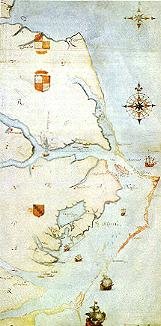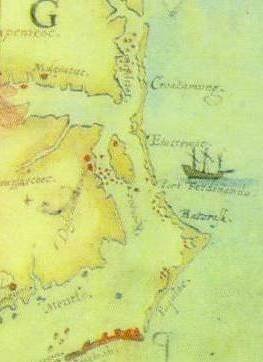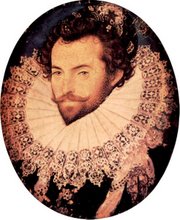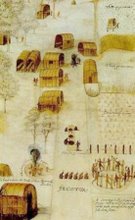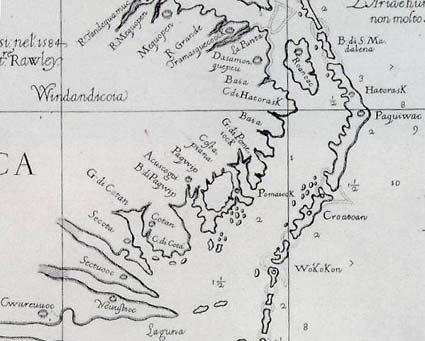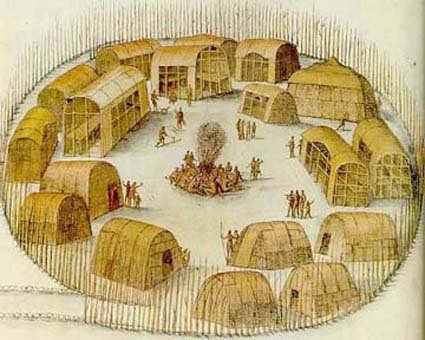
Baum bridge over Roanoke Sound
Day 1 Aug 16 2009 Sunday
By Roberta Estes
I had been looking forward to arriving on the Outer Banks for the Virginia Dare Faire for weeks now. My car looked more like I was moving than going on a working vacation. I felt like a modern day Beverly Hillbilly. Anne has moved into her summer home in Wanchese and I’m contributing things from my mother’s home. It’s only fitting it seems, as Anne and I are on a mission together and I’ll be staying with her from time to time as we research and search for the Colonists.
So the back of my Jeep has the seats laid flat, a table with the legs removed, several boxed with miscellaneous kitchen paraphernalia that each has a memory for me, and of course really important things like books relating to our search, several inches of paper relating to our research plan, and, oh yes, trivial necessities like clothes. Of course, I can’t go anyplace without my electronic tether, or lifeline, whatever the days perspective…..my computer and cell phone. I’d be lost without either.
Last night after arriving, I answered e-mails and sent clients information and kept up with the world outside of Wanchese. But back to the Outer Banks.
I drove from Michigan via Pennsylvania, Maryland and Virginia this time, as opposed to the more westerly route down 77. I have driven that before to Washington DC, but never beyond. The area through Pennsylvania and Maryland is connected to my early German families and I always think that I need to do more research on them and stop and see where they lived. But that trip will have to wait for another time.
Given that I was in the area of our nation’s capital on a weekend, I didn’t mind risking the Capital Beltway, but I’d never do it on a weekday. That’s analogous to taking your tourist type life in your hands. The 150 miles and supposed two hours I would have saved taking this route would have been likely to evaporate in a single traffic jam.
But on Sunday I whizzed around Washington and noticed that building construction continues there. They apparently aren’t experiencing the same level of recession we are suffering under in Michigan where there is no building and many half-constructed buildings have been abandoned and sold at auction. I whispered my perennial prayer for wisdom and guidance for those in power as I drove by….although my prayers perennially seem to go unanswered in regard to politicians.
I stayed in either Thornburg or Woodford. It’s a schizophrenic place. The Google map and the Holiday Inn website say Thornburg, but my GPS doesn’t know Thornburg Virginia exists, so I called the Holiday Inn and they said “oh yea, type in Woodford. Ok, so Woodford it was. And Google had the location the wrong expressway too, but details….who cares. At least my gps could find it after I typed it the second city. Maybe it’s like a maiden name and a married name for women…..
The free internet was awful, the room had once been a smoking room (do they think we can’t smell), but today the entire property is nonsmoking, and I managed to leave have of the cheesekeeper I was using to hold watermelon in my cooler. Rats. I always take a last look around the room too…..but I missed it somehow and I’m sure that the cleaning staff took one look at that and said “oh well” and into the trash it went. One more of Mother’s things I don’t have to figure out what to do with I guess….but that wasn’t what I had in mind.
Next I passed Richmond and Newport News which began to look like a coastal area with boats, ships really, and cranes and port type of paraphernalia towering over the horizon. Before arriving at Newport News, the area looked strikingly colonial, not nautical. I’m always amazed when traveling in the eastern Virginia area, even near large cities, how wooded the landscape remains. The expressways look more like parkways and not like the sprawling cement ribbons that clear everything to desolation with half a mile in all directions that we have in the Midwest.
South of Newport News, I encountered a surprise. My GPS indicated that I was going to cross an expanse of water, which would be my first real glimpse of the Atlantic on this trip. As I approached, I noticed signs for a tunnel. Hmmmm…..now tunnels are not my favorite things, but they are a fact of a driving/traveling lifestyle, and once you’re in route they are impossible to avoid, so tunnel it was. This tunnel was unusual though in that it only went half way across the channel or estuary and rose in the middle of the river (whatever you call these wide entrances into the ocean that empties fresh water into the ocean but is also tidal in nature) and became a bridge for the second two thirds or so of the crossing. How so they keep the tunnel from flooding? Amazing. However, I noticed the large “doors” on the end as I entered which made me a little nervous and could be the makings of a horror movie or a nightmare, but I chose not to think about those. They are probably closed during hurricanes.
Speaking of hurricanes, when I left Michigan, there had been none yet this year. Last night there were 3, one which arrived in Florida already and is weakening, one which is heading for the Caribbean, and one, Bill, who is going northwest of the Caribbean, may become a level 3 or 4 and is likely to strike the mainland by or on Friday. Now of course, this area is prime hurricane alley, much to the chagrin of Sir Walter Raleigh’s military colonists. Sir Francis Drake lost several ships in his visit in August of 1586 on these Outer Banks and he ended up rescuing the military colonists instead of resupplying them….but I digress.
As I approached the Virginia/North Carolina border yesterday, 64 transitioned from an expressway to a non-limited access 4 lane road. This is more than a technical transition and the introduction of stop lights. It was a complete change in flavor from a sterile environment with beehives of activity called exits where travelers stop and never stay beyond the closest meal, bathroom and gas pump to an area where travels pass through, but also where people live. It became alive with businesses, and few if any chains. I saw a few Home Depots, but then again, everyone needs those types of stores and here probably more than most with the constant battle of the elements of wind, sand and sea.
Mostly I saw flavorful and colorful hometown restaurants, fruit stands that advertised “free bathrooms” and Burma shave type signs for upcoming businesses. Somehow we subtracted about 40 years and returned to a slower, sweeter time when travel was more of an adventure and less of a race. I wanted to stop at several gift shops, a pawn shop or two (who knows what jewels await in there) and those luscious looking fruits stands with fresh fruit and local crafts decorating the outside of the barns by the roads. Yes, they are all inviting and call out as you drive by.
Further south, the fields continued and the crops looked healthy. Whoever said that the colonists would have not been able to sustain themselves on these islands? Did they visit and take a look at the agriculture? Sand dunes replace trees and marsh replaced fields eventually. In some places condos hug the very edge of the marshy expanses, making me wonder if some of those condos might just tip over and sink. And of course, facing the sea, I wondered about how to protect them from the raging hurricanes and if they could even purchase insurance, but then again, not my worry, I’m just a visitor. Many of the condos and beach houses weren’t on the beach, and frankly, couldn’t even see the beach. They could just see the other houses that also couldn’t see the beach. Talking to Anne later, she mentioned that even the “unlucky” houses were quite expensive. I have to wonder why you’d spend that kind of money to not be beachfront. I guess I’m way too logical. For me it would be beachfront or nothing at all I guess. If I couldn’t afford beachfront, there would be no point in second string. However, I suspect most of these are rentals or timeshares, so perhaps the answer is that they are investments. If that’s the case, then many of these investments are for sale now. I noticed one street of waterfront units where every single unit had a for sale sign on the side. I guess even if Washington isn’t experiencing our recession, the Outer Banks is, if the amount of real estate for sale is any indication.
Crossing from Manteo to Wanchese is the bouncing bridge. I’ve never been on a bridge that literally makes your car bounce up and down like a large beach ball. Now my Jeep has heavy duty suspension (it’s trailer rated), and that makes it ride a little tighter and not so sloshy as the land yachts, but still, this was a huge bounce. I noticed the pickup truck in front of me was bouncing too and so was whatever was in the pickup bed. The contents of the bed were bouncing at a different pace so the truck “caught” the boxes. I guess the message here is to tie everything down if you have a truck and are crossing the bouncing bridge.
Now I think this is new-fangled speed control device and a pretty good one too because the speed limit was about all the faster you could drive and not bounce yourself to death and into another lane. Each section of the bridge every few feet declined where it connected to the next section and then raised midway a bit, causing the wave action of bouncing up and down.
Arriving at Anne’s house was a real treat. She lived on Old Wharf Road with is the old road around the island. The turn into her road is landmarked by a beautiful old white church. Turning into her place leads you back away from the little old road and her house is back under a very large poplar tree. The tree shades the whole house and you park under the front part. The ground everyplace here is sandy, even if grass manages to grow on top of the sand. A tame female turkey named Turkey Lurkey greeted me. She had to check me out to be sure I was Ok and that I was a female. Turkey Lurkey doesn’t like males for some reason. I passed inspection and she settled down and let Anne pet her after eating some bread scraps. Turkey Lurkey is smart, she can fly over the fence in and out of the pen. Her friends or rather, penmates, the chickens simply stand and squawk at that uppity turkey who has the audacity to stand outside the fence and look back at them like they are, well, birdbrains.
After getting settled in and looking longingly at Anne’s screened in front porch, making mental plans for later, we ventured out for dinner. Most of the businesses and restaurants are closed here on Sunday, another, return to times of the past for me, but we went to a local favorite, Sam & Omie’s, which has been here since 1937. http://www.samandomies.net/ Sam & Omie’s has legendary She Crab Soup. Now what exactly is a She Crab and why do they make soup out of it? Well, duh, it’s a female crab and the soup includes crab roe (that’s eggs). It’s made in a cream based chicken stock broth with a touch of sherry. It’s a specialty of the area, but for Anne, it’s just a special treat for visiting Sam & Omie’s. Anne says the She Crab soup just isn’t right anyplace else.
http://whatscookingamerica.net/History/Chowder/SheCrabSoup.htm
It was yummy, yummy and so was the crab cake I had for dinner. Fresh and you can actually taste the crab. I didn’t even notice any filling but there had to be because it did hold together in a patty. I love the coast for the fresh seafood.
Our next adventure was to the grocery store where a pack of vultures had descended. Our first clue was no carts. No carts? On a Sunday evening? Well, all those rental properties rent from Sunday to Saturday and the new crop of vacationers all arrive at the grocery….you guessed it….on Sunday evening. Thankfully, the grocery was relatively prepared for the descending vacationers and we got in and out relatively quickly with our supplies for lunches this upcoming week. On Tuesday, Anne and I are going to have a table at the Virginia Dare Faire on Tuesday and there isn’t any food service right there. Anne and I take coolers and food and ice cold water. It’s August in the Outer Banks and HOT and HUMID here. And of course we don’t want to leave the table because after all, we’re there to talk to visitors will hopefully come to visit and learn about the colonists.
In preparation for the Faire, we have prepared a “Most Wanted” list of surnames associated with the colonists. We prepared this list based on the colonists’ roster, of course, plus historical records in NC that indicate these surnames were found there early and are associated with Native American tribes in the area.
Hopefully, fate with be with us and some folks will visit the Faire, visit our table and will be interested enough to work with us on their genealogy and maybe, just maybe, will be the right person in their line to take a genealogy DNA test.
Here is our “most wanted” list. Do you have any of these surnames in your family from eastern early North Carolina?
Allen
Bennett
Berry
Barbour
Beasley
Blount
Brooks
Brown
Buck
Carawan
Carroon
Carrow
Chapman
Chavis
Chavous
Cheven
Coleman
Cooper
Dare
Elks
Gibbs
Gurganos
Harris
Hewett
Johnson
Jones
Locklear
Lowrey
Lucas
Martin
Pierce
Scott
Smith
Squires
Payne
If you can’t visit us in Manteo tomorrow at Fort Raleigh at the Waterside Theater, then visit our Lost Colony website.
http://www.rootsweb.ancestry.com/~molcgdrg/
We hope to see you soon!!!
Read all posts in the Trip to Roanoke series:
© History Chasers
Click here to view all recent Searching for the Lost Colony DNA Blog posts 














